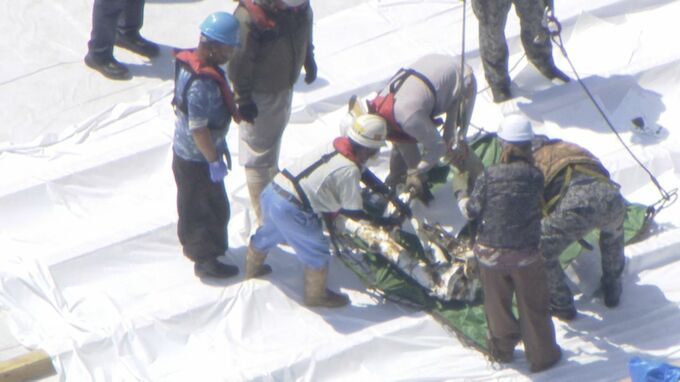In May of this year, a T-4 training aircraft of the Japan Air Self-Defense Force crashed into the Iruka Pond in Inuyama City, Aichi Prefecture. Today, the recovery operation of the aircraft began.
“A part resembling the aircraft was retrieved from the pond.”
This accident occurred in May when a T-4 training aircraft from the JASDF Nyutabaru Air Base in Miyazaki Prefecture crashed into the Iruka Pond in Inuyama City, resulting in the deaths of two crew members.
The Ministry of Defense has been collecting debris since the accident and began lifting the aircraft using a crane this morning.
Approximately 90 personnel are involved in the operation, with measures in place to prevent oil spills.
The aircraft crashed approximately two minutes after departing from Komaki Air Base in Aichi Prefecture. The cause of the accident has not yet been determined. The Ministry of Defense aims to complete the operation by the end of September.
T-4 training aircraft
The **T-4 training aircraft** is a Soviet-era jet trainer developed in the 1960s by the Sukhoi Design Bureau. Designed to prepare pilots for advanced fighter jets like the MiG-21, it featured a tandem-seat cockpit and robust performance for its class. Though never mass-produced, it played a role in testing and training before being succeeded by more advanced models like the L-39 Albatros.
Iruka Pond
Iruka Pond, located in Nara Prefecture, Japan, is a scenic and historically significant site linked to ancient Japanese legends. It is said to be the place where a wounded dolphin (or “iruka”) was saved by villagers, inspiring local folklore and reverence. Today, the pond is a peaceful spot surrounded by nature, often visited for its tranquil beauty and cultural heritage.
Inuyama City
Inuyama City, located in Aichi Prefecture, Japan, is famous for its well-preserved feudal-era charm and Inuyama Castle, one of Japan’s oldest surviving castles, built in 1537. The city is also known for its scenic Kiso River, traditional cormorant fishing (ukai), and the historic Urakuen Tea Garden, which features a teahouse designed by a master of the tea ceremony. With its rich history and cultural heritage, Inuyama offers a glimpse into Japan’s Edo period and traditional arts.
Aichi Prefecture
Aichi Prefecture, located in central Japan, is a vibrant region known for its rich history, modern industry, and cultural heritage. It is home to Nagoya, one of Japan’s largest cities, and historic sites like Nagoya Castle, built in 1612 by the Tokugawa shogunate. Aichi is also famous for its traditional crafts, such as Seto pottery, and as the headquarters of major companies like Toyota.
JASDF Nyutabaru Air Base
The **JASDF Nyutabaru Air Base** is a Japan Air Self-Defense Force (JASDF) facility located in Miyazaki Prefecture, Kyushu. Established in 1944 as an Imperial Japanese Army airfield, it was later used by the U.S. military before being transferred to the JASDF in 1961. Today, it serves as a key training base, hosting fighter squadrons, including the F-15J/DJ Eagles.
Miyazaki Prefecture
Miyazaki Prefecture, located on the southeastern coast of Kyushu Island in Japan, is known for its lush landscapes, warm climate, and rich Shinto heritage. It is home to Takachiho Gorge, a sacred site linked to Japanese mythology, where the sun goddess Amaterasu is said to have hidden in a cave. The region also boasts historic shrines like Udo Jingu and is a popular destination for surfing, agriculture, and eco-tourism.
Komaki Air Base
Komaki Air Base, located in Komaki, Aichi Prefecture, Japan, is a former Imperial Japanese Army airfield that played a significant role during World War II. After the war, it was used by the United States Air Force until 1958, when it was returned to Japan and repurposed as Nagoya Airport for civilian flights. Today, the site is part of the larger Chubu Centrair International Airport operations, though some military functions remain under the Japan Air Self-Defense Force (JASDF).
Ministry of Defense
The **Ministry of Defense** is a key government institution responsible for national security, military strategy, and armed forces administration. Many countries have such ministries, often housed in historically significant buildings, with origins dating back to periods of national military development or post-war reorganization. For example, the **Pentagon** in the U.S. serves as the headquarters of the Department of Defense and was built during World War II (1941-1943).






